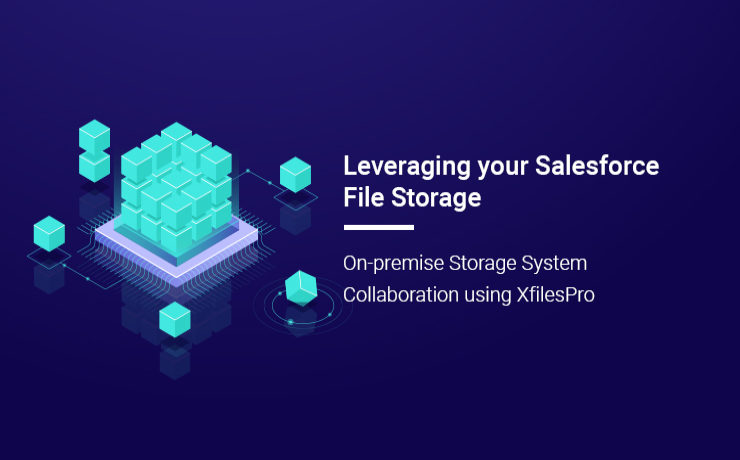Leveraging your Salesforce File Storage: On-premise Storage System Collaboration using XfilesPro

Most of the enterprises today are faced with the massive challenge of managing the immeasurable number of files and attachments in their Salesforce Org. XfilesPro, one of the top Salesforce AppExchange solutions, was designed keeping in mind this issue with file storage. This highly customizable and admin-friendly application was launched to help Salesforce customers seamlessly store and collaborate their files and attachments with various external storage systems. Using XfilesPro, Salesforce admins can significantly reduce their file storage costs while seamlessly enabling a 360-degree file collaboration strategy. When it comes to storing the most confidential files in a secure manner, many organizations prefer to keep these files on the on-premises (Local/Non-Cloud) system, in many cases on a traditional file server. On-premises refers to local hardware, which means the files are stored on local servers, computers, or other similar devices. These on-premise systems are treated as capital expenses and are purchased once. On-premise storage systems offer absolute control over infrastructure and files with the added benefit of security. Some of the key benefits of on-premise systems are mentioned below: The storage resources are procured, owned, and managed by the enterprise itself. The enterprise can exert complete control over and is fully responsible for securing the storage resources and the files. The on-premises storage resources are completely dedicated to the company only. The capital investment for on-premises systems is typically a one-time cost. Also read: XfilesPro 2.0 – Adorn with it’s Next-gen Salesforce File Management Capabilities XfilesPro can easily be implemented to collaborate the native Salesforce system with various On-premise systems like SMB, SFTP, and Network Drive. XfilesPro enables systems connected via the Server Message Block (SMB) network protocol to access and share files from other local computers very easily. Using the Secure File Transfer Protocol (SFTP), that provides access to remote systems to deliver secure communications, alongside XfilesPro is the optimal method for secure file transfer. When using a corporate network, a network drive can provide easy access to customer information stored on it. Even though a network drive is almost similar to a local disk drive, the most prominent difference is in the manner of file transfer. In a network drive, the files are transferred from a remote system to the internal servers over a secured network connection. Using XfilesPro can greatly simplify the processes involved in transferring these files while also offering additional security. To know more about on-premises system collaboration using XfilesPro, please get in touch with us. There are several challenges associated with on-premises storage systems: File sharing between offices is challenging High maintenance cost Lack of mobility Lack of administrative control To overcome these challenges while still enjoying seamless collaboration with external storage systems, various cloud-based options are also available in the market. Cloud storage involves storing data on remote servers or hardware that are maintained by a third-party service provider. As you can expect, cloud storage is almost always cheaper than on-premises solutions. By using cloud storage, enterprises can buy a specific amount of storage space based on their organization\’s needs. Another benefit of cloud storage is the ability to access files from anywhere, anytime. Keeping these benefits in mind, XfilesPro also offers seamless collaboration with various cloud-based storage systems such as OneDrive, Amazon S3, Google Drive, SharePoint, and Dropbox. Some of the significant functionalities such as an efficient file and folder hierarchy management, centralized content management system, large volume file migration, multi-org file integration, and community portal collaboration help XfilesPro in integrating the Salesforce system with external systems. To know more about external storage collaboration using XfilesPro, set up a free demo today. AMARLAL
Managing your Salesforce Files in a Superior Manner: XfilesPro’s Auto-Export Feature

Managing the immeasurable number of files and attachments in the Salesforce Org becomes a hassle for most of the enterprises. XfilesPro is one of the top AppExchange applications for file management and external storage collaboration that lets enterprises seamlessly store and collaborate their Salesforce files and attachments with various external storage solutions such as OneDrive, Google Drive, SharePoint, Amazon S3, DropBox and many more. This application performs exceptionally well with Service Cloud, Experience/Community Cloud, Sales Cloud, and Salesforce Platform. This highly customizable and admin-friendly application helps Salesforce customers not only reduce their file storage costs significantly (nearly up to 70%), but also seamlessly enable 360-degree file collaboration including integration with various external storage systems. Enterprises can also experience a centralized content management system, efficient file and folder hierarchy management, multi-org file integration service, capacity to undertake large volume file migration as well as community portal collaboration. Learn more about XfilesPro’s file management capabilities. Usually when enterprises implement XfilesPro for managing the files in their Salesforce Org, they are burdened by an enormous amount of such files and attachments, sometimes over 100 GBs. Upon successful implementation of the application, using the Limitless Initial Offload feature they move these files to their desired external storage platform, at once. But after this initial offload, the subsequently generated files and attachments have to be monitored and periodically moved to the external storage. To ease the burden of a Salesforce admin and to do away with the constant regulation and supervision of files, XfilesPro introduced the Auto-Export feature. With this feature, the XfilesPro application itself takes care of the Salesforce files and periodically moves them to the external storage system integrated with the Salesforce application. This can be done on an hourly, daily, weekly or monthly basis or at the end of the day, or even weekly; as is deemed necessary by the Salesforce admin when he sets the batch and time interval for the file export process. There are several advantages of this feature: No Manual Intervention – The application automatically takes care of the file export process, which cuts back the need for any kind of manual labor. No File Limitations – Due to this feature, XfilesPro can manage millions of files and records without any difficulties. No Supervision Required – As the entire process is automatic, no supervision from the Salesforce admin is required, which gives him sufficient time to focus on other things. One Time Execution – The batch and time interval for the export process has to be set only once, after which the application manages the files automatically, based on the set parameters. Enhanced Security – In case of any process failure which is rare, files will not be lost as XfilesPro engine smartly handles and re-initiate migration of those files. If you want to know more about the Auto-Export feature or about the XfilesPro application, please get in touch with our system experts here or set up a free demo here. AMARLAL
A Brief Overview of Advanced Document Management in Salesforce
Today, enterprises expect their CRM systems to be more than just document repositories because of workflows, proposals, agreements and various other client information need to be managed periodically. Therefore document management is definitely one of the most important features that companies look for in their CRM systems. This feature facilitates nearly all of the sales processes, providing content to clients and partners. Therefore Salesforce, being one of the leading CRM platforms in the world, has a number of functions that can satisfy most if not all the needs of business users. When it comes to Salesforce, it’s unique and exceptional file and document management system takes utmost care to reduce a Salesforce admin’s complexities by simplifying file management, enhancing presentation skills, catering to all sorts of files, and finally managing these files efficiently. Not only this, having dealt with myriad types of documents, Salesforce has been constantly improvising to cater to the latest technology and needs. Salesforce has 5 off-the-shell modules for files and document management with several variations. These inbuilt modules include: Attachments– One of the first tools launched by Salesforce was Attachments. As is obvious from the name, it allows users to create Attachment lists and attach different types of files to particular Salesforce records (like, a contract, offer, or proposal). In this case, the size limit of the file to be attached is 25 MB, when attached directly to the Attachment list, whereas even for multiple files attached to the same email the size limit remains 25 MB, with a maximum size of 5 MB per file. Documents Tab– Salesforce Documents Tab allows users to store their web-based resources and Visualforce files, such as custom logos and DOT files, in folders without attaching them to any particular records. Though this file is not attached to any record, it can easily be accessed or used whenever its need arises. For example, users can add a custom logo to the meeting requests by uploading the stored logo directly to the documents tab. Files Home– Salesforce Files Home is a kind of cloud-based repository where files can be uploaded, privately stored, synced and shared among team members and coworkers to kick-start Chatter collaboration. This document repository specifically stores files without any association to objects. It also allows synchronizing the information in the documents in real-time, across all devices, including desktop and mobile. It also has a plethora of exquisite features such as file filtering, drag-and-drop, file syncing, and files-specific search tools. Salesforce Files ideally suits co-working on unique documents, like client proposals. Salesforce Knowledge– Salesforce Knowledge is a corporate knowledge-sharing platform, commonly used for creating a base for information sharing among employees. It allows users to create, edit, search, organize, and share knowledge articles in libraries among the organization\’s employees. Users can also use Salesforce knowledge and a particular web portal to share documents with their clients outside the organization. It supports a maximum file size of 5 MB for all attachments. Salesforce CRM Content– Salesforce CRM Content is the most widely used content management tool that lets users create, duplicate, work, and modify official corporate documents, like case studies or sales presentations, in such a manner that only the creator can work on it. Once they are ready, it also allows them to make this content accessible for their coworkers as well as to external users such as clients, partners, and customers in the form of content packets. As the storage space in Salesforce is already limited, rather than extending these limits, it recommended to use different cloud-based storage services so as to ease the pressure. Salesforce launched Salesforce File Connect, an OOTB tool, for exactly this purpose of integrating the Salesforce system with other external systems. But even this tool has its limitations, so it’s better to choose an alternative integration solution. And the best place to look for these solutions is the Salesforce AppExchange marketplace. One such AppExchange application that can help you seamlessly store and collaborate files with external systems is XfilesPro. This highly customizable and admin-friendly application performs exceptionally well with Service Cloud, Experience/Community Cloud, Sales Cloud, and Salesforce Platform. With XfilesPro, Salesforce admins can not only seamlessly enable a 360-degree file collaboration including integration with various external storage systems, but they can also cut back on their file storage costs significantly. Learn more about XfilesPro’s file management capabilities. XfilesPro can be used to collaborate the Salesforce system with various external files storage systems like Cloud-based storage systems like Google Shared Drive, OneDrive, Amazon S3, SharePoint, and Dropbox and On-premise systems like SMB, SFTP, and Network Drive. Loaded with features like a centralized content management system, efficient file and folder hierarchy management, multi-org file integration, large-volume file migration, and community portal collaboration, XfilesPro is an ideal solution for integrating Salesforce with cloud-based systems. To know more about XfilesPro and how it can facilitate external system integration with Salesforce, please get in touch with us. AMARLAL

